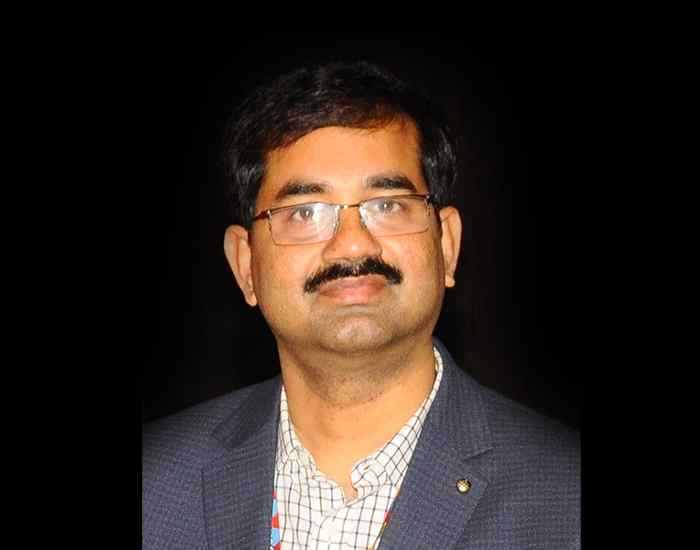
S. P. Rath
PhD (IACS, Kolkata)
Professor, Department of Chemistry
Research Interest
Unfolding Mystery of Multi-Heme Cytochromes Multiheme cytochromes, that are recognizably different from the monoheme cytochromes, constitute a widespread class of proteins with essential functions in electron transfer and enzymatic catalysis. However, the structural and functional significance of such arrangements is not yet understood. Understanding the significance of these heme structural motifs is crucial for the elucidation of the highly optimized properties of multiheme cytochromes which we are currently engaged in.
Modeling Di-heme Cytochromes: Effect of Inter-macrocyclic Interactions The diheme cytochrome c (DHC2) from G. sulfurreducens is, however, the simplest member of Multiheme cytochromes family, with two heme groups attached through a single polypeptide chain that are found to be different. The observed differences in the axial ligand orientations and porphyrin ring deformations between two heme centers in DHC2 have been proposed to be the consequences of heme-heme interactions which will be explored in details.
Probing Molecular Chirality using Metallo-Bisporphyrin Hosts Supramolecular chirogenesis is one of the most important interdisciplinary field to be looked into, because of its occurrences in many natural (DNA double helix, heme proteins, secondary α-helix structure of proteins etc.) and artificial systems. Exciton Coupled Circular Dichroism (ECCD) is a nonempirical spectroscopic method that is based on detecting the through-space exciton interaction between helically orientated independently conjugated chromophores. Our group is currently engaged in investigating the various aspects of chirality induction and control for probing molecular chirality using Exciton Coupled Circular Dichroism (ECCD).
Light-induced Electron/Energy Transfer The photosynthetic reaction center proteins from Rhodopseudomonas viridis and Rhodobacter spheroides have been isolated in pure form and structurally characterized with X-ray crystallography. The heart of the photosynthetic reaction centre is a pair of chlorophyll molecules, often referred to as the 'special pair'. One of the problems to be solved is the role of pair of chlorophylls, which are placed face-to-face in green plants and photosynthetic bacteria.
CL-205C ,
Department of Chemistry
IIT Kanpur,
Kanpur 208016
Specialization
Bio‐inorganic Chemistry
Education
PhD (1999), IACS, KolkataThesis Supervisor:Prof. Animesh Chakravorty
M.Sc., (Specialization in Inorganic Chemistry): Calcutta University (1994)
B.Sc., (Honors in Chemistry): Calcutta University (1992)
Teaching Area
Primary teaching area:
Inorganic Chemistry
Current Teaching
Inorganic Chemistry
Coordination Chemistry
Bio-inorganic Chemistry
Crystal and Molecular Structure Determination
Applications of Modern Instrumental Methods
Professional Affiliations
Selected Publications
Awards & Fellowships
Research Result
Keywords
Professional Experience
Professor, Department of Chemistry,Indian Institute of Technology Kanpur, June 2014 to date
AvH Fellow (Experienced Researcher) (academic host Prof. Dr. Peter Comba)Anorganisch-Chemisches InstituteHeidelberg University, GermanyDec. 2012-to-July, 2013
Associate Professor, Department of ChemistryIndian Institute of Technology Kanpur, May 2009-May 2014
Assistant Professor, Department of ChemistryIndian Institute of Technology Kanpur, Dec. 2004-April 2009
NIH Post-doctoral Research Associate (with Prof. Alan L. Balch)Department of Chemistry, University of California, Davis, USA. 2001-2004
Current Research
Rath's group at IIT Kanpur is engaged studying a wide range of bioinorganic and biological systems, all of which fall under the general theme of gaining a better understanding of the heme centers in heme proteins that are vital to the life of almost all living organisms. The group is currently engaged in several broad research areas such as: Unfolding Mystery of Multi-Heme Cytochromes Multiheme cytochromes c constitutes a widespread class of proteins with essential functions in electron transfer and enzymatic catalysis. Understanding the significance of these motifs is crucial for the elucidation of the highly optimized properties of multiheme cytochromes c. Probing Molecular Chirality using Metallo-Bisporphyrin Hosts with Exciton Coupled Circular Dichroism (ECCD) The relative orientation of two chromophores in space in a chiral host-guest complex results in a bisignate CD curve with two bands of opposite sign and similar intensity in the porphyrin spectral regions which is diagnostic of the guest's absolute configuration. Light Induced Electron/Energy Transfer One of the problems to be solved was the role of 'special pair' in photosynthsis which is being investigated extensively. The Rath's group has been using extensively a wide variety of spectroscopic techniques including X-ray diffraction study, variable temperature magnetic, NMR, EPR and Mössbauer spectroscopy and also DFT for structure-function correlation. The progress of the reactions are monitored in situ in solution along with the structural elucidation utilizing paramagnetic NMR spectroscopic technique.



